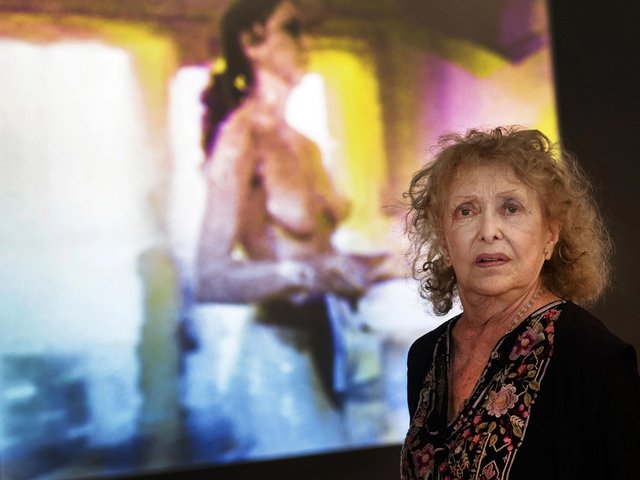London
Charles Baudelaire once declared genius to be nothing other than the ability to retrieve childhood at will. Pipilotti Rist is not, one suspects, a genius. But her kitschy, loveable, and at times sensually ravishing videos and installations confer a kind of license on viewers to wallow guiltlessly in an atmosphere of childish reverie.
Rist is currently the subject of a solo exhibition at Utrecht’s Centraal Museum (until 18 November). Phaidon last month published the first English-language monograph on her, and an artist’s book she has created, entitled Pipilotti Rist: apricots along the streets, is due to be released by Scalo on 15 October.
This follows by about a week the opening of yet another solo show at the Museo Nacional Centro de Arte Reina Sofía in Madrid (9 October to 21 January 2002). Until 3 October, Rist will also have a video work entitled “The belly button like a village square”, commissioned by England’s Public Art Development Trust, projected onto a vast outdoor screen in London’s South Bank cultural precinct.
Rist has exhibited her work in Utrecht’s Centraal Museum once before, in a group exhibition last year. Scattered among the rooms housing the museum’s permanent collection, which includes 16th-century Utrecht Masters, modern Contructivist and Surrealist works and an elaborate 18th-century doll’s house, are a number of special project rooms in which the museum regularly invites contemporary artists to exhibit.
One of these rooms is a cavernous, two-level chapel, which was once part of the medieval St Agnes Convent. Rist has colonised this dauntingly large space with one of her most ambitious and successful pieces, an installation entitled “Expecting”, commissioned by the Centraal Museum and completed this year.
The chapel’s tall windows have been covered by colourful patchwork quilts, filtering kindergarten-coloured light into the interior. Several videos project (sometimes via rotating mirrors) onto the walls, the lower chapel’s ceiling, and a hanging spiral of lace patchwork into which one can walk.
The effect of blur and disorientation is absolutely characteristic of Rist’s work, and is heightened by the use of slow motion and a dreamy, melodic soundtrack interspersed with electronic blips and sonic interference. (Rist composes her music in collaboration with Anders Guggisberg; she started her creative career as a stage designer for pop bands whose video clips she occasionally directed.) The lyrics–“I have a mouth with which I eat/and when I run I use my feet”–contribute, too, to the overall mood of child-like marvelling.
Among the seven other videos and installations in the exhibition is Rist’s breakthrough work, “I’m not the girl who misses much”, 1986. This shows a woman dressed in an absurd costume (it is in fact Rist; she appears in most of her own works) dancing to the opening refrain of the Beatles’ White Album ditty, “Happiness is a warm gun.”
Both the song and the visuals are repeatedly thrown into high speed then slowed down again, so that the dancing woman is made to resemble a pathetic and demented marionette. The video is broken up by sonic and visual interference, and the whole is powerfully suggestive of some kind of mental breakdown.
Rist, whose star is about as high as anyone’s in the contemporary art world, is often claimed on behalf of feminism, or, rather more confusingly, ‘“post-feminism”. She herself has described feminism as, for her, “a question of honour, of noblesse oblige”. But the reality underlying much of her work is that she habitually conflates femininity and infantilism–and not always, one feels, with an ironic edge.
There is something dippy and not a little hippy about Pipilotti Rist and her yearning for pre-Oedipal pleasures. Her eagerness to submerge herself and her audience in childish sensuality–indulged in, however, by adult bodies–is undoubtedly one source of her appeal; at times it all feels as lovely as watching cake mixture pouring into an oven tin. But at other times, so much aimless drift has something sticky and torpid about it.
Rist’s videos do, however, tend to have a threatening undertow, which lets a sense of the real world back in. While her suggestions of menace are sometimes no more than another means of inducing sensual vertigo, they are generally enough to keep her audiences guessing.
Rist has recognised the insistent, bullying nature of so much video art, which forces one, if only by its utter absence of eventfulness, to stay to the bitter end, hoping vainly to deduce some crucial plot-development one presumably missed by coming in after the beginning. Instead, her loops do away with any notion of beginning, middle or end. One can leave at any point, without having to hunch over in shame as one sneaks out.
“People,” she has said, “don’t have to give a specific part of their lives to see a thing if they don’t want to.” To this extent, her work announces a return, of sorts, to the diffuse, freewheeling attentiveness viewers traditionally brought to art galleries before the onset of video art.
Originally appeared in The Art Newspaper as 'Hippy, dippy and hi-tech'


